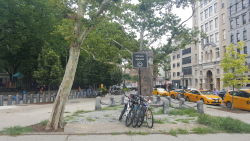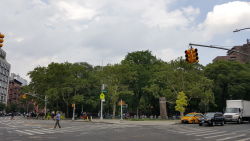Straus Square
Straus Square
Straus Square is named for Nathan Straus (1848-1931), who was born in Otterberg, Rhenish Bavaria (now Germany) on January 31, 1848. His father, Lazarus, emigrated to America in 1852, and the rest of the family followed in 1854. They settled in Talbotton, Georgia. Nathan’s formal education included Sunday School classes with a Baptist minister and preparatory schooling in Georgia; advanced studies, religious instruction, and Hebrew lessons in Alabama; and professional training at Packard Business College in New York City, where the family moved after the Civil War.
Nathan’s shrewd mind, tremendous energy, and kind heart all contributed to an outstanding business career. As the international representative for L. Straus & Sons, the family’s crockery and glass firm, Nathan traveled across America to open new markets and throughout Europe to acquire new products. He forged an alliance with R.H. Macy, and by 1896 the Strauses were sole owners of Macy’s famous department store in Manhattan and partners in the Abraham & Straus department store in Brooklyn. In 1902 the family opened the world’s largest department store, Macy’s at Herald Square. Nathan promoted the welfare of Macy’s employees by providing a dining hall with full meals for just five cents; offering personal gifts of money, clothing, and medical treatment; and, with his brother Isidor, establishing a Mutual Aid Society.
After the deaths of Isidor and his wife Ida aboard the S.S. Titanic in 1912, Nathan retired from business and devoted himself to family, charity, and public service. He and his wife Lina Gutherz Straus had six children, two of whom died at an early age. Nathan’s concern for all children inspired him to promote milk pasteurization in the United States. He established a pasteurization laboratory in 1892 and inaugurated milk distribution programs throughout the country. As a philanthropist, Nathan gave generously to support health, disaster relief, and charity, and he championed the establishment of a Jewish state in Palestine. In public life, he served as a member of the board of commissioners of the Department of Public Parks in New York City from 1890 to 1894, chairman of the New York State Forest Commission, and president of the city’s Board of Health in 1898. He was president of the American Jewish Congress from 1918 to 1920. Nathan Straus died in New York City on January 11, 1931.
Less than a month after his death, the New York City Board of Aldermen named this triangular plot in his memory. The report issued by the Commission on Public Thoroughfares proclaimed that "the designation of Straus Square pays tribute to the memory of a beloved son of New York who distinguished himself as a citizen, philanthropist and patriot." Formerly known as Rutgers Square, the plot at the intersection of East Broadway, Rutgers Street, and Canal Street (here Straus Square) is located in the heart of the Lower East Side. Several of Nathan’s milk stations operated in this neighborhood, and he supplied a milk bar on the roof garden of the Educational Alliance, a settlement house and community center which stands to the east of Straus Square.
In 1953 the Manhattan Borough President and members of the Veterans of Foreign Wars gathered at the site to dedicate a monument to the men and women of the Lower East Side who served in World War I, World War II, and the Korean War. In 1998 six new London Plane trees were planted along the perimeter of the square. The noble ideals of Nathan Straus and the valiant wartime service of local men and women are remembered at this small downtown park.
Check out your park's Vital Signs
Clean & Safe
Green & Resilient
Empowered & Engaged Users
Share your feedback or learn more about how this park is part of a
Vital Park System


